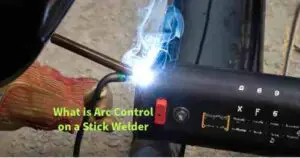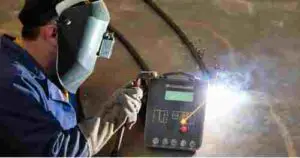Table of Contents
- Arc Control on a Stick Welder: Unveiling the Basics
- What is Stick Welding?
- The Importance of Arc Control
- How Arc Control Works
- Factors Influencing Arc Control
- Benefits of Proper Arc Control
- Common Arc Control Problems
- Tips for Improving Arc Control
- Safety Measures in Stick Welding
- Best Practices for Arc Control
- Choosing the Right Electrode
- Arc Control and Different Metals
- Arc Control vs. Voltage Control
- Conclusion
- FAQs
Welding, the art of joining metals, has been an essential skill in various industries for centuries. When it comes to stick welding, understanding the nuances of arc control is crucial for achieving impeccable welds. In this comprehensive guide, we will delve deep into the world of arc control on a stick welder, shedding light on its significance, techniques, and best practices.
Arc Control on a Stick Welder: Unveiling the Basics
Stick welding is a welding process that uses a consumable electrode coated in flux to create an electric arc. This arc generates the high temperatures needed to melt the base metals and the electrode, creating a fusion between them. Arc control plays a pivotal role in determining the quality and strength of the weld.
What is Stick Welding?
Stick welding or SMAW, is a manual welding process where the welder controls the welding arc. It is characterized by its simplicity and versatility, making it suitable for various applications, including construction, repair, and maintenance.
The Importance of Arc Control
Arc control refers to the ability of the welder to manipulate the size, stability, and behavior of the electric arc during welding. This control is vital because it directly affects the quality of the weld. Proper arc control ensures that the welding process is stable, and controlled, and results in high-quality welds.
How Arc Control Works
Arc control is achieved by adjusting various parameters, such as amperage, electrode angle, and arc length. These adjustments allow the welder to regulate the heat input, penetration depth, and weld bead shape.
Factors Influencing Arc Control
Several factors influence arc control, including:
- Amperage: Adjusting the welding machine’s amperage setting determines the heat generated by the arc.
- Electrode Angle: The angle at which the electrode is held affects the arc’s stability and penetration.
- Arc Length: Maintaining the right arc length is crucial for controlling the arc and preventing issues like spatter.
Benefits of Proper Arc Control
Proper arc control offers several advantages:
- Higher Weld Quality: Welds produced with precise arc control exhibit better fusion and fewer defects.
- Reduced Spatter: Controlling the arc minimizes spatter, making cleanup easier.
- Improved Weld Appearance: A well-controlled arc results in a smoother and more aesthetically pleasing weld bead.
Common Arc Control Problems
Welders may encounter challenges related to arc control, including:
- Excessive Spatter: Inadequate control can lead to excessive spatter, which affects the quality of the weld.
- Lack of Penetration: Poor arc control may result in insufficient penetration, weakening the weld’s integrity.
- Uneven Bead Shape: Improper control can cause uneven and irregular weld bead shapes.
Tips for Improving Arc Control
To enhance arc control, consider the following tips:
- Practice: Regular practice helps welders gain better control over the arc.
- Adjust Settings: Experiment with amperage and electrode angle to find the optimal settings for your specific welding job.
- Maintain Electrode Angle: Consistently maintaining the correct electrode angle is essential for stability.
Safety Measures in Stick Welding
While focusing on arc control, safety should never be overlooked. Welders should wear appropriate protective gear, including helmets with auto-darkening filters, welding gloves, and flame-resistant clothing, to ensure their safety during the welding process.
Best Practices for Arc Control
Following these best practices for arc control will lead to successful welding projects:
- Inspect Equipment: Regularly inspect your welding equipment to ensure it’s in good working condition.
- Clean Base Metal: Remove any contaminants or rust from the base metal before welding.
- Monitor Arc Length: Continuously monitor and adjust the arc length as needed during welding.
Choosing the Right Electrode
The choice of electrode plays a crucial role in arc control. Different electrodes have varying characteristics, so selecting the right one for your specific welding job is essential.
Arc Control and Different Metals
The type of metal being welded also influences arc control. Some metals require more precise control due to their unique properties.
Arc Control vs. Voltage Control
Arc control is often confused with voltage control, but they are distinct concepts. Voltage control regulates the electrical potential, while arc control focuses on manipulating the arc itself.
Conclusion
Arc control on a stick welder is a skill that elevates your welding game to the next level. By understanding the fundamentals, mastering techniques, and embracing the advantages, you can become a welding pro with the ability to create impeccable welds consistently. Remember, practice makes perfect, so keep honing your arc control skills, and you’ll be welding like a seasoned pro in no time.
FAQs
Q1. What is the primary purpose of arc control in stick welding?
Answer: Arc control ensures the stability and quality of the welding process, resulting in strong and reliable welds.
Q2. Can improper arc control lead to welding defects?
Answer: Yes, inadequate arc control can result in welding defects such as spatter, lack of penetration, and uneven bead shape.
Q3. Is arc control the same as voltage control?
Answer: No, arc control focuses on manipulating the welding arc, while voltage control regulates the electrical potential.
Q4, Why is electrode angle important in arc control?
Answer: The electrode angle affects arc stability and penetration, making it a critical aspect of arc control.
Q5. What safety measures should welders take during stick welding?
Answer: Welders should wear appropriate protective gear, including helmets, gloves, and flame-resistant clothing, to ensure their safety during stick welding.




1 thought on “What is Arc Control on a Stick Welder”